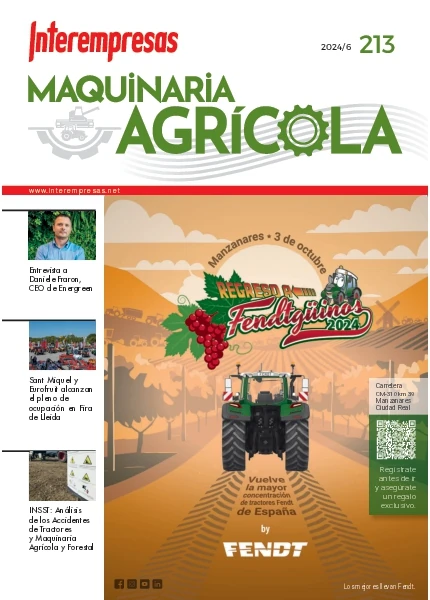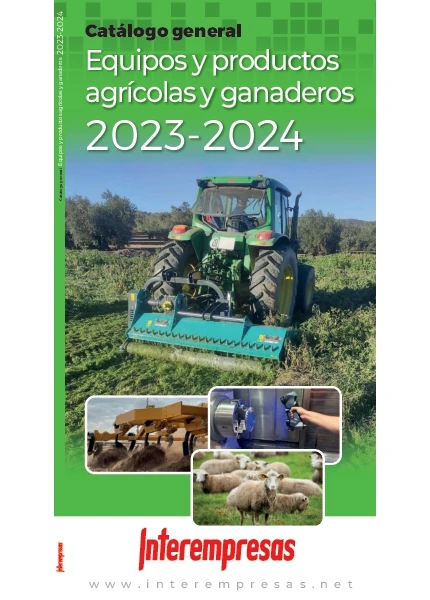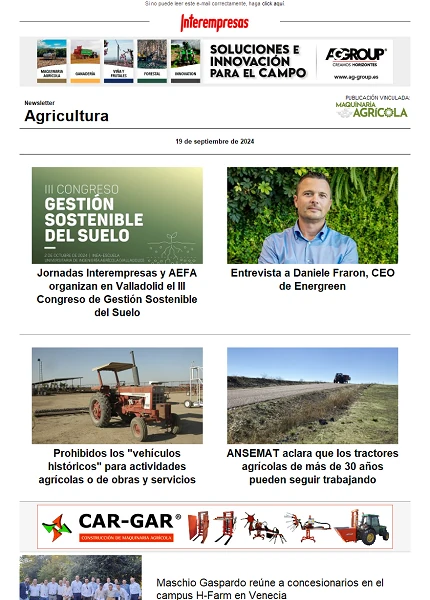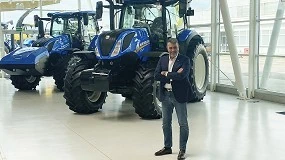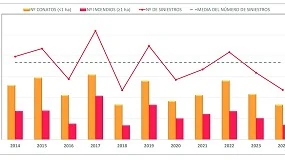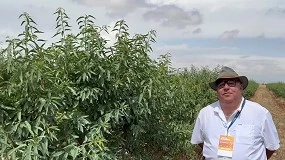Manejo del riego y la poda en plantaciones de olivar en seto
Más reciente aún es un sistema de cultivo del olivar donde la densidad aumenta espectacularmente, pasando de los 100 y 300 olivos/ha a 1.500-2.000 olivos/ha. En este nuevo tipo de plantaciones, llamadas en seto o superintensivas, los olivos se forman a un eje y las distancias entre árboles varían de 1,35 a 2 m. Esto hace que, tras tres años de crecimiento, se formen setos continuos que son recogidos por máquinas cabalgadoras.
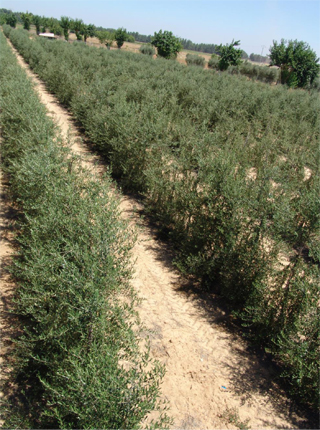
Plantación olivar en seto en Finca La Orden, variedad arbequina.
La primera experiencia de olivar en seto se realizó en Italia, pero las plantaciones comerciales de seto surgieron en España en 1993 extendiéndose a otros países como Portugal, Francia, Italia, Marruecos, Chile, Túnez o Estados Unidos. Desde entonces, el incremento en el número de hectáreas plantadas ha ido en aumento pudiéndose estimar que en la actualidad se pueden encontrar en torno a las 100.000 ha. En España se concentra el 50% del total mundial de olivares en seto. El éxito de este sistema reside en dos grandes ventajas frente a sistemas menos intensivos: la rápida entrada en producción y la mecanización de las operaciones de cultivo, principalmente recolección y poda. Esto reduce drásticamente la necesidad de mano de obra propia del cultivo tradicional y que constituye unos de los mayores problemas económicos para la sostenibilidad de este cultivo.
Sin embargo, esta olivicultura de alta densidad presenta una serie de inconvenientes como son los elevados costes de implantación junto con algunos condicionantes técnicos como el requerir de variedades poco vigorosas, parcelas de cultivo de ciertas dimensiones, poco accidentadas, en riego y con disponibilidad de maquinaria. A esto le sumamos que el manejo del cultivo es más complicado principalmente en lo que se refiere al control del vigor que es un aspecto crítico del sistema que condiciona el mantenimiento de la productividad y por tanto la rentabilidad y vida útil de la plantación.
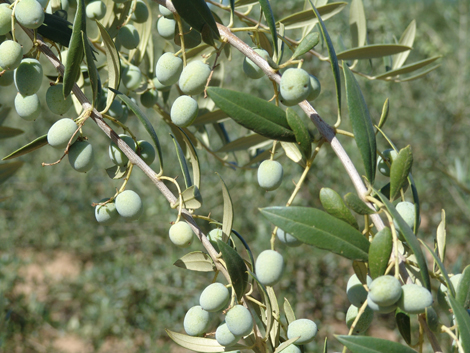
Dentro de los costes de mantenimiento del olivar, la recolección, el riego y la poda son las que suponen un mayor porcentaje dentro del balance económico total de la explotación con un 75% del total de los gastos. Mientras que la recolección esta prácticamente resuelta con la utilización de máquinas cabalgadoras que agilizan esta labor y reducen su costo, una buena gestión del riego y la poda son puntos clave de éxito de este sistema.
El CICYTEX-Finca La Orden lleva trabajando desde el año 2009 en riego en olivar en seto y desde el año 2011 en estrategias de podas semimecánicas y totalmente mecanizada en estos sistemas y dispone de información preliminar sobre el manejo de estas dos labores de cultivo.
Manejo del riego en plantaciones de olivares en seto
Para un correcto uso del agua de riego es importante conocer tanto las necesidades hídricas de un olivar, como la sensibilidad a la falta de agua en cada fase de cultivo y así poder diseñar la mejor estrategia de riego que compatibilice producción, calidad y rentabilidad y obtener el máximo potencial de este recurso.
Por un lado, hay que diferenciar entre plantaciones en formación y plantaciones adultas para el diseño de la estrategia correcta. Cuando nos encontramos con plantaciones jóvenes en formación es importante favorecer el crecimiento de los árboles para alcanzar lo antes posible la plena producción. En plantaciones tradicionales e intensivas de olivar se recomienda el uso de un riego con necesidades totales para los primeros años del cultivo y se desaconseja totalmente aplicar estrategias de riego deficitarias. Sin embargo, en el caso del olivar en seto, se alcanza un alto porcentaje de interceptación de radiación mucho antes que en los otros sistemas, por lo que el uso de riegos deficitarios en los primeros años podría ser una opción interesante. El objetivo es conseguir una buena productividad y un control del vigor del seto que es uno de los mayores problemas de estos sistemas con variedades no adaptadas completamente a marcos de plantación tan sumamente intensivos.

Con respecto a la diferente sensibilidad a la falta de agua según el ciclo del cultivo se pueden distinguir 3 fases bien definidas:
- Fase I: se inicia con la brotación del árbol (primeros de marzo), continuando con la floración-cuajado de frutos para finalizar con el endurecimiento del hueso de las aceitunas (primeros de julio).
- Fase II: comprende el período desde endurecimiento de hueso y finaliza al inicio de septiembre (10-15 días antes de envero).
- Fase III: abarca desde inicio de septiembre hasta la cosecha (noviembre).
La fase II es el período menos sensible a la falta de agua y donde mayores recortes en riego se pueden realizar sin bajar la producción del olivar y ahorrar gran cantidad de agua al ser la época de mayor demanda hídrica. Por el contrario, la fase I y III son períodos sensibles a la falta de agua ya que un recorte de caudal, incluso ligero, bajaría la producción final del cultivo aunque puede tener algunas ventajas que conviene valorar: un recorte en el agua aplicada con dosis insuficientes para cubrir las necesidades del cultivo controlaría el crecimiento vegetativo (fase I) y aumentaría el rendimiento graso de las aceitunas en fase III.
En el CICYTEX- Finca La Orden, se han probado diferentes estrategias de riego deficitario en olivares en seto en formación durante los primeros 4 años de desarrollo obteniéndose resultados muy interesantes con el empleo de un déficit ligero en estos primeros estadios. El uso de dosis de riego un 40% inferiores a una estrategia de riego para cubrir las necesidades del olivar (4.000 m3/ha de promedio en los 4 primeros años para riego total), no supuso una pérdida de productividad en la plantación con producciones entorno a los 10.000 kg/ha de promedio, con la ventaja de un mayor control del crecimiento vegetativo (7,8% menos de volumen de copa) y por tanto menos intensidad en podas de formación cuantificadas en un 16% menos. Esta estrategia de riego deficitario controlado se aplicó con un porcentaje diferente según las fases de cultivo aprovechando el máximo los períodos mas y menos sensibles a la falta de agua y fue del 75-40-65% para las fases I, II y III respectivamente, considerando los valores porcentuales respecto a las necesidades del olivar. Sin embargo, no se consiguió aumentar el rendimiento graso al final del cultivo, para lo cual hay que aplicar tratamientos más severos que implica una pérdida en producción de aceituna.
Métodos de la poda en plantaciones de olivares en seto
En olivar se pueden diferenciar 3 tipos de poda según el desarrollo de la plantación: podas de formación, de producción y de renovación.
La poda de formación se suele realizar en los 3 primeros años tras la implantación y consiste en mantener el árbol en un eje central con los respectivos atados cada 20 cm al tutor. La única intervención de poda que debe realizarse es la de dejar 1/3 libre de la parte inferior del árbol libre de ramas.
Al partir del tercer año comienzan a realizarse poda de producción. Esta consiste en una poda de rebaje o ‘topping’ para mantener el árbol en altura, una poda lateral para evitar una anchura excesiva del seto y por último una poda de las faldas o ‘Skirting’ para eliminar ramas bajeras que impidan los tratamientos herbicidas y que además es una zona que la máquina de recolección no recoge.
- La poda de rebaje o topping se realiza mecánicamente con barra de discos rotativos y cortantes a una altura entre 2,5-2,7 m para evitar el sombreamiento de los laterales del seto (marcos de plantación en torno a 3,5 m de calle) y para mantener la dimensión adecuada para el pase de la cabalgadora en la recolección de la aceituna. La época suele ser en invierno (febrero) aunque puede ser interesante realizarla en verano (agosto) o incluso en ambas épocas (2 veces al año). Este es un tema que interesa poner a punto mediante trabajos de investigación y experimentación para comprobar que época o frecuencia es la más correcta de usar.
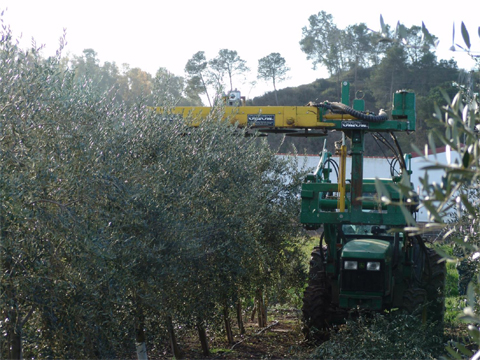
- La poda lateral consiste tanto en mantener una anchura del seto adecuada para la máquina de recolección (100-120 cm) como mantener el eje central y evitar que el olivar se vuelva improductivo por un excesivo sombreamiento interno den el seto. Este tipo de poda suele realizarse manualmente debido a que las intervenciones laterales suelen ser pocas y consisten en eliminar ramas con grandes dimensiones dirigidas hacia la calle. Aun así, el coste que supone este tipo de poda puede elevar los costes de producción y cada vez son más los olivicultores que están optando por una mecanización total de la poda. La maquinaria sería la misma que la utilizada para el topping pero con una orientación vertical y a una distancia de unos 20 cm del eje del árbol. Este tipo de poda suele realizarse sobre una cara del seto (poda por caras), manteniendo la otra sin tocar para asegurar producción, y eliminando la otra al año siguiente (poda al 50%) o cada dos años (25%) dependiendo de la recuperación del seto. También se puede hacer por calles con una maquinaria con dos brazos de discos. En este caso se pasaría en una calle de cada dos (50%), cada tres (33%) o una de cada cuatro (25%).
- En cuanto a la poda de ramas bajeras o Skirting suele hacerse mecánicamente con máquinas recortadoras de bajos que se acoplan a la parte delantera del tractor o bien con cortadoras de seto manual a una altura entre 50-60 cm del suelo.
La mecanización total de la poda o el uso de un sistema combinado semi-mecánico (manual en los laterales y mecánica en altura y bajeras) supone ahorros importantes en los costes de esta operación de cultivo en un 90% y 65% en peonadas con respecto a una poda totalmente manual desaconsejada en estos sistemas. Aunque con el primer tipo el ahorro de mano de obra es considerable, las podas no son selectivas y habrá que valorar productivamente hablando la duración y mantenimiento de la viabilidad en estas plantaciones.
Por último, la poda de renovación sólo será precisa en caso que el olivar de seto deje de ser productivo debido a un mal manejo o envejecimiento del cultivo. En este caso son varias las opciones a seguir todas ellas válidas y a elegir a criterio del agricultor:
a) Renovación mediante podas consistentes en cortar el tronco del seto siendo las mejores soluciones probadas a unos 5-10 cm del suelo.
b) Eliminación de un árbol de cada dos y transformar la el superintensivo en un olivar intensivo.
c) Arrancar la plantación y realizar una nueva.
En el CICYTEX- Finca La Orden se está realizando un ensayo probando diferentes estrategias de poda de producción en un olivar en seto desde su 4º año desde plantación (2011-2013). Las estrategias empleadas consisten en tres podas semimecánicas y una poda totalmente mecanizada. Entre las semimecánicas la única diferencia es la época y frecuencia del la poda de rebaje o topping, siendo la poda lateral manual y la de las zonas bajeras mecanizada en todos los casos.
La primera estrategia 'P1' consiste en una poda topping en invierno, mientras que 'P2' fue en verano y 'P3' en invierno y verano. La poda totalmente mecanizada 'P4' consiste en un topping en invierno, poda lateral mecanizada al 25% por caras y poda mecanizada de las faldas. Los resultados tras tres años de experiencia muestran que las producciones solo fueron ligeramente inferiores en la poda 'P3' (topping invierno-verano) mientras que en el resto de tratamientos fue similar. Sin embargo, existen indicios de que el contenido graso varió con las estrategias de poda empleadas mostrando 'P3' y 'P4' los mayores contenidos grasos que se tradujo en una mayor producción de aceite de los árboles con poda totalmente mecanizada (P4) y compensó la producción de aceite en el tratamiento 'P3' (2 topping). Estos datos son prometedores en cuanto a la mecanización total del cultivo aunque hay que estudiar estas estrategias de poda a más largo para ver si se sostienen en el tiempo y no decaen las producciones por el uso de podas no selectivas.
Conclusiones
Se puede concluir en cuanto al manejo de riego y poda en olivar que el uso de estrategias de riego deficitarias ligeras (>40% de un riego según necesidades totales) resultan muy aconsejables en olivares en seto de formación ya que mantienen la productividad y controlan el vigor durante la formación del seto. En cuanto a las podas de producción, la mecanización total de esta operación puede resultar sumamente interesante ya que supone un ahorro en costes de cultivo. Manteniendo la productividad del seto, tanto en las estrategias de riego como en las de poda, es necesario evaluar el efecto a medio y largo plazo.
Agradecimientos
Este trabajo ha sido financiado por el INIA (RTA2008-00033-C 02-00), CICYTEX y por el FEDER.


